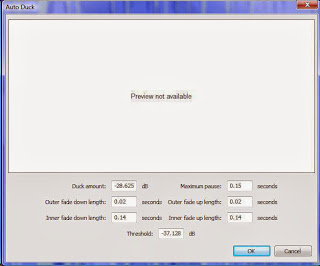First of all, remember that the best de-esser is done whilst recording, with the pop filter and conscious attenuated 's's, 'p's, 'c's and 't's. If in case you apply a compressor for augmenting the loudness and diminishing the dynamic range, as I do, you will notice these consonants' amplitude to be increased(because the compressor I use increases the amplitude of lower volume waves and mitigates|or wholly halts| the amplification of higher volume waves.) That's what this mini-guide is all about.
Procedure to de-es a vocal track the fastest possible way.
First of all avoid hard sibilants and
plosives while recording. When mistakes are made, use Audacity to
edit the vocal track.
First of all, duplicate twice the
original vocal track and name the original: “original vocal” so
that we can work on the copies whilst the original is left unchanged. Name the duplicate:
“duplicate”, and the other duplicate: “just in case.”
On the “just in case” track, apply the
spitFish de-esser, available for free, as a VSTi plug-in. Audacity
accepts the plug-in as long as you put the DLL on the “plugins”
folder where Audacity was saved.
Instead of using the default settings
use the sense and depth at max and tune at 5.5 Khz . Most importantly
activate the “listen” switch which will cause the detected
specified samples to remain, instead of being eliminated. Clicking on
“OK” will create an “S” sounding track. Check whether only "S"s were highlighted, otherwise silence(«ctrl+l» while selected) the samples that do not inhere.
Play it back checking once again that it did avoid non "S"s like "SH"s, "CH" and occasionally "T"s. Otherwise recheck the "just in case track" for non pertaining samples and silence them(«ctrl+l» while selected).
Amplify those "S"s that seem to attenuated, and call the "compressor" plugin in case you are in hurry, and can't bother to verify each "S"s decent amplitude.
Using the “duplicate” track, and ensuring that the "just in case" track is bellow it,
apply the auto duck (included by default with Audacity) with the following parameters:
Duck amount: 28,625 dB
Outer fade down length: 0,02
seconds
Inner fade down length:
0,14 seconds
Maximum pause: 0,15
seconds
Outer fade up length: 0,02
seconds
Inner fade up length: 0,14
seconds
Threshold:
-37,128 dB
Once clicked on
OK, you will observe the “S”s highly reduced in amplitude on the "duplicate" track. Now
try Compress dynamics with the following parameters:
Compress ratio:
1,0
Compression hardness:
0,905
Floor:
-46,1
Noise gate falloff:
7,9
Maximum amplitude:
0,99
And later reapply
the AutoDuck filter on the same "duplicate" track, using the "just in case" track as the side-chaining accomplice. Checking whether it reduced the amplitude of a non “S” is redundant(since you already rechecked it in the first pass).
You have finished.


